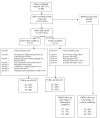The STEP into Action study: a peer-based, personal risk network-focused HIV prevention intervention with injection drug users in Baltimore, Maryland
- PMID: 21054614
- PMCID: PMC3049994
- DOI: 10.1111/j.1360-0443.2010.03146.x
The STEP into Action study: a peer-based, personal risk network-focused HIV prevention intervention with injection drug users in Baltimore, Maryland
Abstract
Aims: To assess the effectiveness of a peer-based, personal risk network-focused HIV prevention intervention to (i) train injection drug users (IDUs) to reduce injection and sex risk behaviors, (ii) conduct outreach to behaviorally risky individuals in their personal social networks [called risk network members (RNM)], and (iii) reduce RNM HIV risk behaviors.
Design: Randomized controlled trial with prospective data collection at 6, 12 and 18 months. Intervention condition consisted of five group sessions, one individual session and one session with Index and the RNM.
Setting: This study was conducted in Baltimore, Maryland from March 2004 to March 2006.
Participants: (i) Index participants were aged ≥ 18 years and self-reported injection drug use in the prior 6 months and (ii) their RNM who were aged ≥ 18 years and drug users or sex partners of Index.
Measurements: Outcomes included: (i) injection risk based on sharing needles, cookers and cotton for injection and drug splitting, (ii) sex risk based on number of sex partners, condom use and exchanging sex and (iii) Index HIV outreach behaviors.
Findings: A total of 227 Index participants recruited 336 RNM. Retention of Index at 18-month follow-up exceeded 85%. Findings suggest that the experimental condition was efficacious at 18 months in reducing Index participant injection risk [odds ratio (OR) = 0.38; 95% confidence interval (CI) = 0.18-0.77), drug-splitting risk (OR = 0.46; 95% CI = 0.25-0.88) and sex risk among Index (OR = 0.53; 95% CI = 0.34-0.86). Significant intervention effect on increased condom use among female RNM was observed (OR = 0.34; 95% CI = 0.18-0.62).
Conclusions: Training active IDU to promote HIV prevention with behaviorally risky individuals in their networks is feasible, efficacious and sustainable.
© 2010 The Authors, Addiction © 2010 Society for the Study of Addiction.
Figures



References
-
- Center for HIV Surveillance and Epidemiology . Baltimore City Epidemiologic Profile – fourth quarter 2008. Maryland Department of Health and Mental Hygiene; available at http:/eh.dhmh.md.gov/ideah/default.aspx.
-
- Mehta SH, Galai N, Astemborski J, et al. HIV incidence among injection drug users in Baltimore, Maryland (1988-2004) J Acquir Immune Defic Syndr. 2006;43:368–372. - PubMed
Publication types
MeSH terms
Grants and funding
LinkOut - more resources
Full Text Sources
Medical

